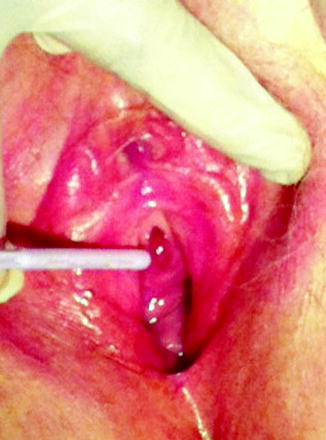(1)
Department Obstetrics & Gynaecology, St George Hospital, Kogarah, New South Wales, Australia
Abstract
When examining a patient with urinary incontinence or prolapse, more care may be needed to be taken to avoid embarrassment than with the usual gynecology patient.
When examining a patient with urinary incontinence or prolapse, more care may need to be taken to avoid embarrassment than with the usual gynecology patient.
For example, a patient with menorrhagia is often fed up with her symptoms and just seeks your help to get rid of a practical problem that has little social stigma. On the other hand, a patient with incontinence often feels that she is “dirty” and “cannot control herself.” A patient with prolapse is often horrified about the lump appearing at her vaginal opening and may have ceased intercourse because of embarrassment.
Therefore, always make sure that the patient’s abdomen and genitalia are covered with a sheet, and only expose that part which you are about to examine. Establish a sympathetic rapport before you begin the examination.
Examine the Abdomen
Before starting the examination, a urine specimen should be taken for culture, and if foul smelling, it should undergo a rapid dipstick test to screen for infection. The patient’s height and weight should be measured, so that BMI can be determined and obesity discussed if present.
Many patients attending the gynecologist for a first visit lie on the couch with their knees drawn up, assuming that only the vagina and pelvis will be examined. This is not appropriate in urogynecology: the abdomen must be examined first, so ask the patient to drop her knees down so that a relaxed abdominal exam can be performed. Check that you know the nature of all her abdominal scars; she may have forgotten some during the history!
Any mass that raises intra-abdominal pressure may cause incontinence.
In our unit, we see one to two patients per annum presenting with incontinence or urgency/frequency who in fact have an ovarian cyst (benign or malignant), or an enlarged uterus that has previously been undetected.
Also, patients may present with frequency and urgency but in fact have subacute retention, so it is important to percuss the abdomen to exclude an enlarged bladder. Shifting dullness needs to be elicited if ascites is suspected, which may accompany an ovarian cancer that provokes stress incontinence.
Check the renal angles for tenderness, for example, calculi.
Inspect the Vulva
First, look for evidence of postmenopausal atrophy. Initially, this appears as thin, shiny, glistening red epithelium that appears fragile, rather than the healthy pink “skin”-like appearance of the premenopausal women. Later changes include patchy whitish areas of cornification with some “cracks” or fissure-like lesions often between the labia majora and minora. In end stage, the labia minora may be fused at the midline. Urethral caruncle, a red rosebud appearance at the urethral meatus, also indicates estrogen deprivation (see Fig. 2.1).


Figure 2.1
Classic atrophic vagina with urethral caruncle
Do not be lulled into a sense of security because the patient is on systemic HRT. A percentage of these patients do not achieve adequate blood levels in the vagina and vulva and may still get atrophic changes, which also affect the urethra.
Next, look at the introitus at rest; a cystocele or rectocele may be evident even without cough. Inspect the perineum for signs of post-obstetric perineal deficiency.
Elicit a “Stress Leak”
Part the labia, and ask the patient to cough. In order to save embarrassment, explain to the woman that you will place a piece of tissue/paper towel at the urethra, so that if she leaks, nothing will spill onto the linen. Patients are often terrified that they will leak urine in front of the doctor, yet this is exactly what we are trying to get them to do. You should have a tissue ready in any case, because a strong projectile spurt of urine may reach your clothing and embarrass the women even further (she will know if the spurt has been large enough to do this!).
Typically, a stress leak involves a short spurt of urine that occurs during the height of the cough effort. An urge leak typically occurs an instant after the cough, but a large prolonged urine leak is seen due to the detrusor contraction.
In practice, patients with urge incontinence will not get up onto your examining couch with a full bladder; they will always request to visit the toilet first.
Assess hypermobility of the anterior vaginal wall. When the patient coughs, there may not be a proper cystocele “bulge,” but the whole anterior wall may move down with the cough.
Speculum Examination
Pass a Bivalve Speculum
Always check that the cervix is healthy, and take a Pap smear if due. As you withdraw the speculum, check for normal vaginal epithelium as in any gynecological exam.
Stay updated, free articles. Join our Telegram channel

Full access? Get Clinical Tree


